Earlier this week, Exxon Mobil released its energy outlook, forecasting that global energy demand will grow by 25 percent by 2040 and that oil and natural gas will capture a combined 60 percent of the 2040 market, with natural gas primarily substituting for coal’s projected decline.[i] Demand would have doubled by 2040 if it were not for the efficiency improvements that Exxon Mobil expects by 2040 as depicted in the graph below. Energy demand growth will mainly occur in developing nations with China and India garnering over half of the expected 25-percent growth. Despite energy demand continuing to grow due to an increase of 25 percent in global population, Exxon Mobil expects carbon dioxide emissions to peak around 2030 and for its intensity (carbon dioxide emissions per unit of the world’s GDP) to be halved by 2040.
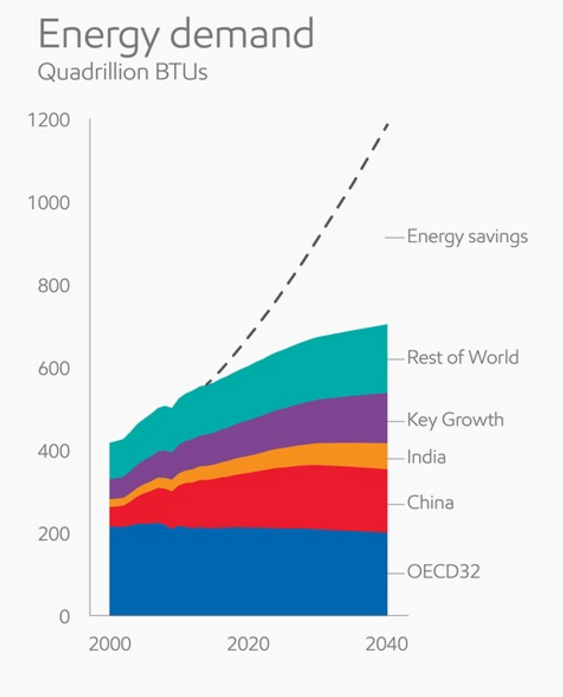
Source: Exxon Mobil, http://corporate.exxonmobil.com/en/energy/energy-outlook/charts-2016
Note: Key Growth countries are 10 nations whose rising population and living standards drive strong increases in energy demand. The 10 nations are Brazil, Mexico, South Africa, Nigeria, Egypt, Turkey, Saudi Arabia, Iran, Thailand and Indonesia. Together, they account for 30 percent of the projected growth in energy demand through 2040.
OECD 32 countries are the Organization for Economic Cooperation and Development nations including the United States, but excluding Mexico and Turkey, which are covered in the Key Growth countries. Energy demand in the OECD32 is expected to decline by 5 percent between 2014 and 2040.
Exxon’s annual energy outlook is one of several global outlooks, including one by the Energy Information Administration, which represents the world “gold standard” for energy projections, due to the quality and extent of data used to compile it.
Lower Forecast for China’s Energy Demand Growth
Exxon Mobil lowered its forecast for China’s annual energy demand growth by almost a tenth to 2.2 percent through 2025. Exxon then predicted that China’s energy demand would plateau around 2030, resulting in an annual energy demand growth between 2025 and 2040 of only 0.2 percent. Despite China accounting for almost half of the global growth in energy demand between 2000 and 2014, Exxon predicts that almost half of the increase in the world’s energy demand through 2040 will come from China and India together. In 2012, China’s GDP increased at about double the rate of energy-consumption growth. According to data from China and the World Bank, in 2015, China’s GDP grew over six times faster than energy-demand growth–China’s energy consumption increased by 0.9 percent in 2015, despite gross domestic product increasing 6.9 percent–the weakest annual rate in 25 years.[ii]
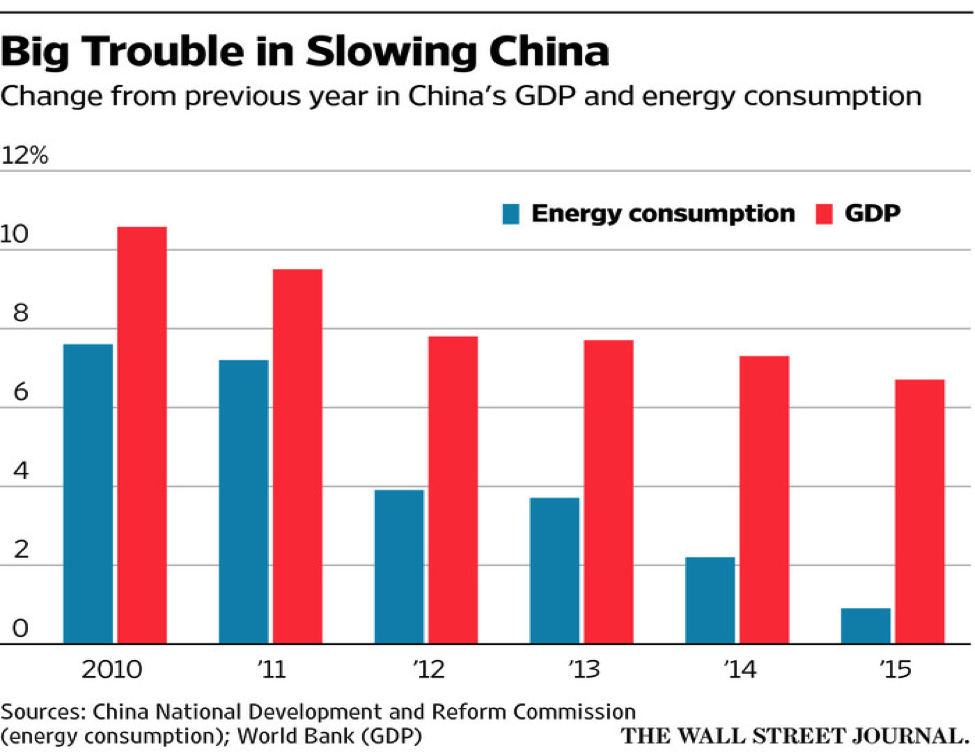
Source: WSJ, http://www.wsj.com/articles/china-slowdown-stokes-fears-on-peak-oil-demand-1453736237
Light Duty Vehicle Energy Demand
Exxon expects all regions to increase the size of their light duty vehicle fleet—cars, SUVs and pickup trucks–with China leading that growth. Exxon expects China’s light duty vehicle fleet to grow by 250 percent to over 400 million vehicles, surpassing the United States as the nation with the most light duty vehicles by around 2025.
The amount of fuel used by light duty vehicles declines in the United States and in the countries that make up the Organization of Economic Cooperation and Development (OECD). In China, light duty vehicle demand increases, and then flattens as fuel economy improves and car penetration slows. (See chart below.) Exxon expects light duty vehicle demand outside the OECD and China to grow about 50 percent; the non-OECD share of global light-duty demand increases from 40 percent today to 60 percent in 2040 in Exxon’s forecast.
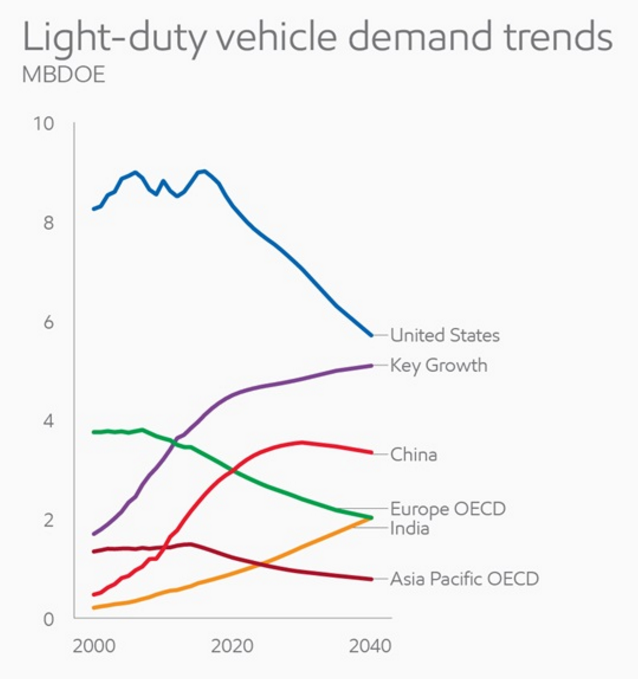
Source: Exxon Mobil, http://corporate.exxonmobil.com/en/energy/energy-outlook/charts-2016
Exxon Mobil expects the average fuel economy of the light duty fleet to increase from 25 miles per gallon today to 45 miles per gallon in 2040, but it varies widely by region. The increase in average fuel economy makes average fuel consumption decrease by half to about 5 liters per 100 kilometers. (See graph below.) Exxon expects one of every four cars on the world’s roads to be a hybrid by 2040 with conventional vehicles (primarily powered by gasoline) continuing to be the most popular.
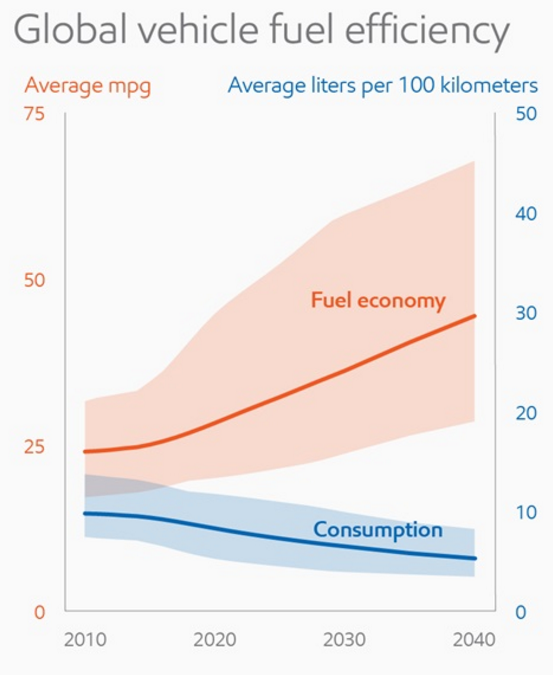
Source: Exxon Mobil, http://corporate.exxonmobil.com/en/energy/energy-outlook/charts-2016
Electricity Demand
According to Exxon, 85 percent of the increased electricity demand between 2014 and 2040 will come from non-OECD countries. China will lead the growth in electricity demand, using one-fourth of the world’s electricity by 2040. India’s electricity usage will increase 185 percent during that time period. The United States’ share of global electricity demand is expected to decline from 20 percent in 2014 to 15 percent in 2040. (See chart below.)
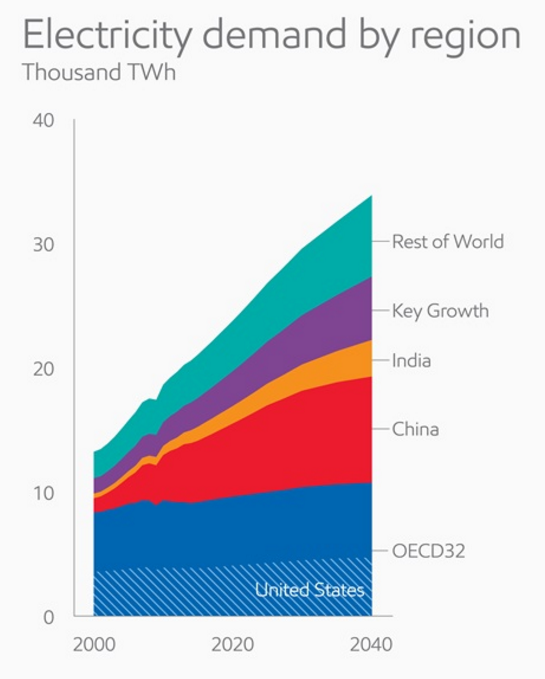
Source: Exxon Mobil, http://corporate.exxonmobil.com/en/energy/energy-outlook/charts-2016
Exxon Mobil expects coal’s share of the world’s electricity to decline from 40 percent in 2014 to 30 percent in 2040, with natural gas, nuclear, wind, and solar increasing their shares. Wind and solar increase their combined share from 4 percent in 2014 to over 10 percent in 2040. (See graph below.)
Despite the decrease in coal’s share globally, India more than doubles its coal-fired electricity use between 2014 and 2040. Exxon expects China to use mostly natural gas, nuclear power, and renewables to meet its growth in electricity demand. The OECD countries lead the shift away from coal, turning to natural gas, wind, and solar.
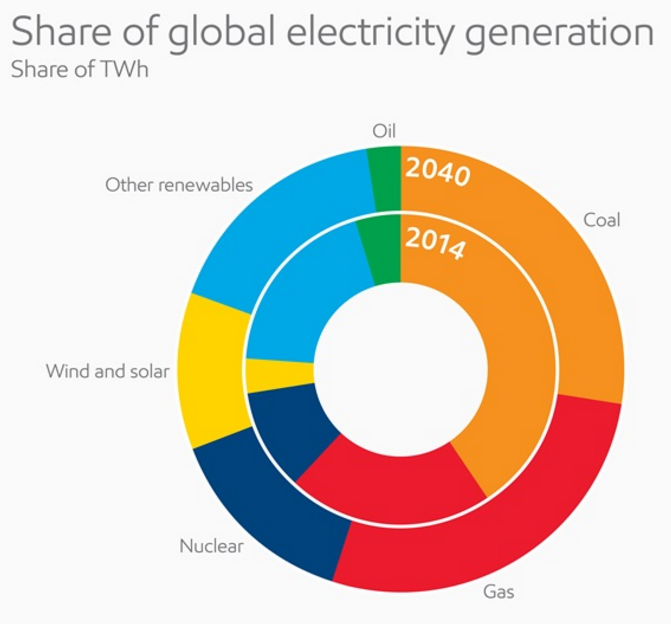
Source: Exxon Mobil, http://corporate.exxonmobil.com/en/energy/energy-outlook/charts-2016
As a result, nuclear capacity is expected to increase by 85 percent between 2014 and 2040, led by China. Wind and solar combined are expected to have 3 times the capacity of nuclear in 2040, but provide less electricity because of their intermittency. Globally, less than 30 percent of wind capacity is able to be used, and for solar, it is less than 20 percent since the wind and solar resources are not always available.
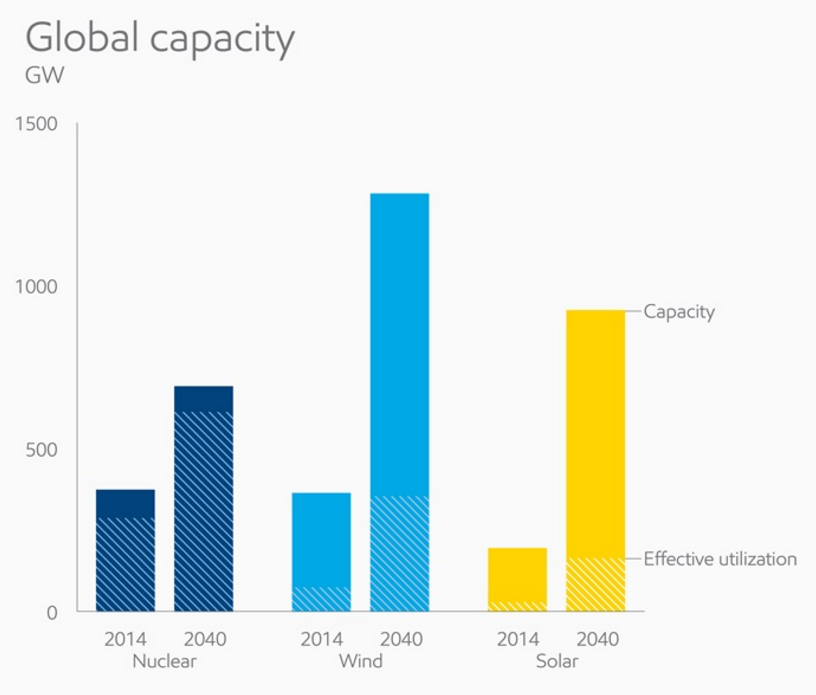
Source: Exxon Mobil, http://corporate.exxonmobil.com/en/energy/energy-outlook/charts-2016
Global Fuel Demand
Exxon projects that oil will remain the world’s major fuel through 2040, increasing 25 percent between 2014 and 2040 and remaining essential to transportation demand and chemicals production. Natural gas is expected to increase the most (56 percent), over taking coal as the second most demanded fuel, as many countries seek to reduce carbon dioxide emissions, substituting natural gas for coal in the generation sector. Coal’s share of world energy is expected to decline from 26 percent to 20 percent in Exxon’s forecast. Nuclear and renewables increase through 2040, with nuclear and biomass each having an 8 percent share in 2040, hydro with a 3 percent share and other renewables with a 4 percent share.[iii]
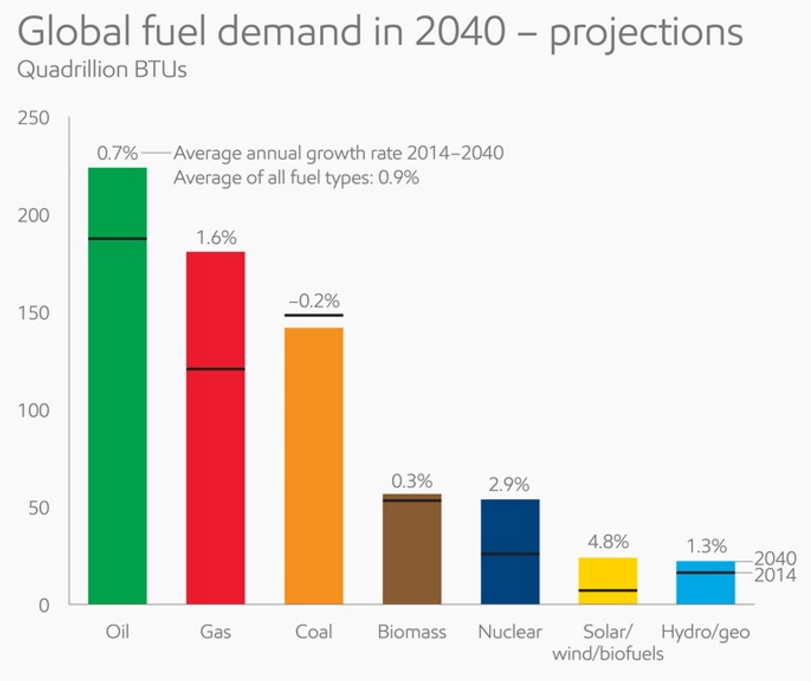
Source: Exxon Mobil, http://corporate.exxonmobil.com/en/energy/energy-outlook/charts-2016
Carbon Dioxide Emissions
Exxon expects global carbon dioxide emissions to peak around 2030 and then decline, following the path expected by China. Despite the peak in 2030, carbon dioxide emissions are still expected to be about 11 percent higher in 2040 than in 2014. Exxon Mobil expects carbon dioxide emissions to decline by 21 percent in industrialized nations but increase 32 percent in developing countries, notably India and countries in Latin America. (See chart below.)
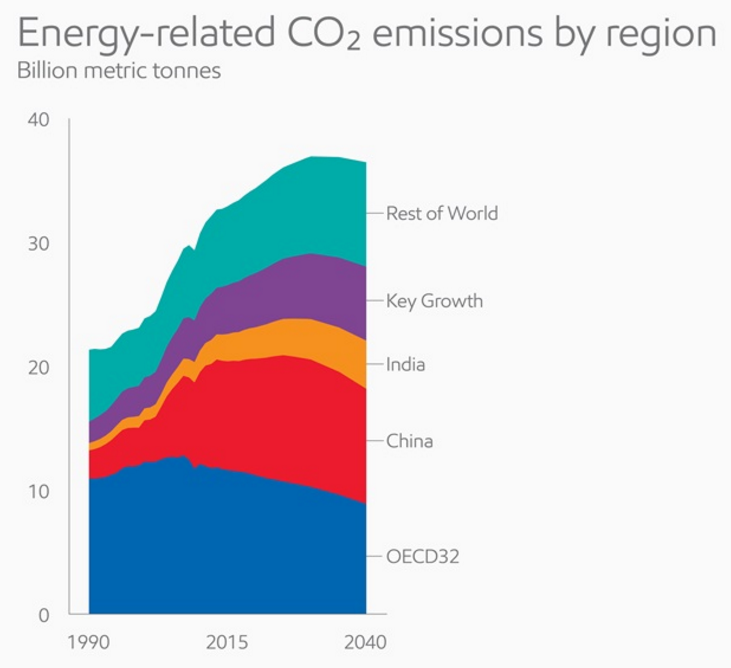
Source: Exxon Mobil, http://corporate.exxonmobil.com/en/energy/energy-outlook/charts-2016
Exxon depicts the difference in options for reducing carbon dioxide emissions from the electric generation sector by comparing generation shares for the United States and Germany. The United States shifted from coal to natural gas, adding less wind and solar generation than Germany, whose energy transition resulted in phasing out nuclear power and adding more wind and solar power. Both nations reduced carbon dioxide intensity—carbon dioxide emissions per unit of electricity—but, the carbon dioxide intensity in the United States dropped about 3.5 times as much as that of Germany. (See chart below.) Carbon dioxide emissions in the power sector dropped 15 percent between 2005 and 2012 in the United States while in Germany, they dropped less than 5 percent.
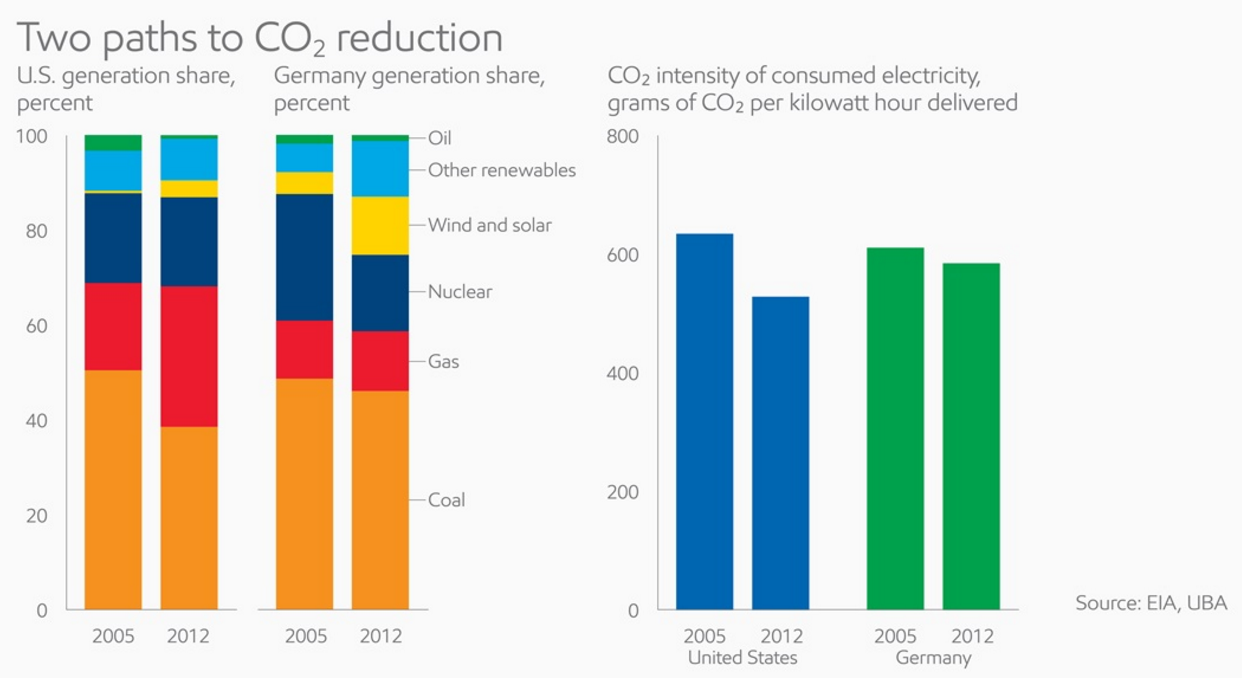
Source: Exxon Mobil, http://corporate.exxonmobil.com/en/energy/energy-outlook/charts-2016
Reducing carbon dioxide emissions is not free, as many politicians and environmentalists want the public to believe. Exxon provided a range of costs for different ways that one can reduce carbon dioxide emissions in the United States. The company finds that the best value for reducing these emissions is by improving the fuel economy of conventional vehicles, followed by switching from coal to natural gas in power generation markets. Wind, solar, and electric vehicles are at the high end of the various cost possibilities for reducing carbon dioxide emissions as the graph below depicts. Electric cars, for example, could cost upwards of $800 per metric ton of carbon dioxide abated.
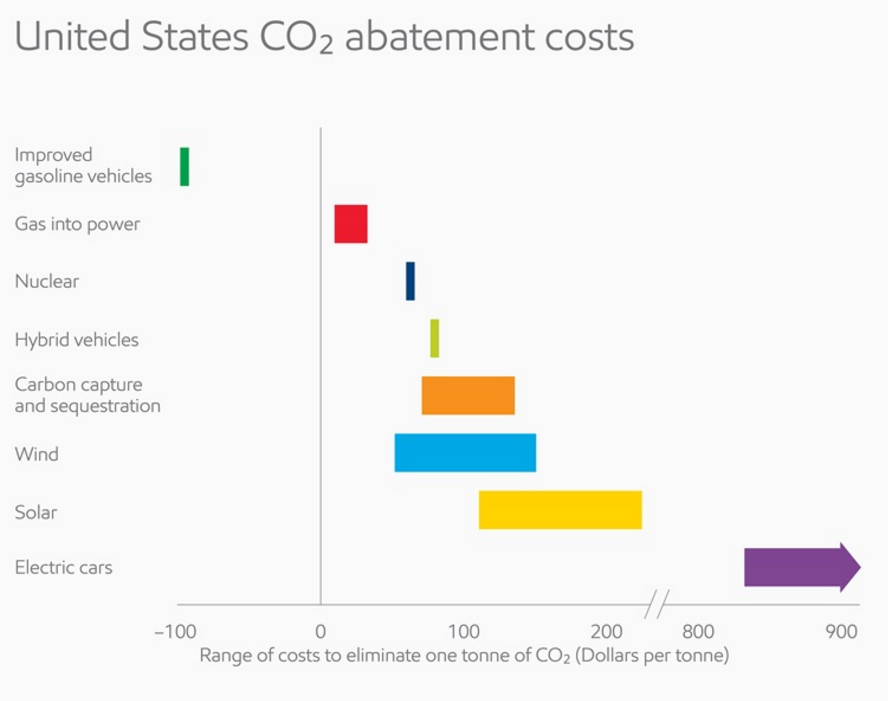
Source: Exxon Mobil, http://corporate.exxonmobil.com/en/energy/energy-outlook/charts-2016
Conclusion
Exxon Mobil projects that oil and natural gas will remain the dominant fuels for the future despite gains in nuclear power, wind, and solar power. This results from oil’s dominance in the transportation fuel market and chemicals production and natural gas’ abundance and competition with coal in the generation market. The company expects energy efficiency improvements to keep energy demand to a growth of just 25 percent between 2014 and 2040 and carbon emissions to peak around 2030. Coal’s dominance as the second most consumed fuel is replaced by natural gas, but many developing countries still turn to coal for electricity generation for its price, ease of use and abundance.
[i] Exxon Mobil, The Outlook for Energy: A View to 2040, January 2016, http://corporate.exxonmobil.com/en/energy/energy-outlook/introduction/a-view-to-2040
[ii] Wall Street Journal, China Slowdown Stokes Fears of Peak Oil Demand, January 25, 2016, http://www.wsj.com/articles/china-slowdown-stokes-fears-on-peak-oil-demand-1453736237
[iii] CBS News, Exxon: Oil and gas will still dominate energy in 2040, January 25, 2016, http://www.cbsnews.com/news/exxon-oil-and-gas-will-still-dominate-energy-in-2040/



